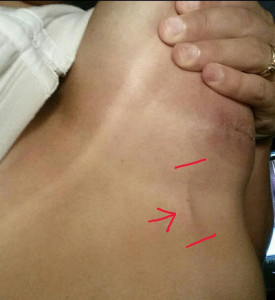Surgery of the breast is very common in women with breast augmentation being the most common aesthetic operation. There are many potential complications of breast augmentation surgery but fortunately most of them are minor and some of them are even self-solving. Technically if an after surgery problem eventually resolves on its own without surgical treatment it is not considered a complication but a temporary ‘nuisance’.

Mondor’s Cord is named after the famous French surgeon in Paris, Dr. Henri Mondor, who first described it way back in 1939. While most commonly occurring on the breast/chest wall, such thrombophlebitic cords can also occur on the extremities such as the arms and penis after trauma and surgery.
These cord-like bands occur just under the skin and run from the lower pole of the breast into the upper abdominal area. These swollen hard veins are quite distinct and may have some mild discomfort associated with them particularly when raising the arm above one;s head on the affected side which places the cord under maximal stretch. Like most thrombophlebitic conditions they are usually self-resolving and will go away with time. For those Mondor’s cords that are uncomfortable and develop redness, they can be treated with low heat (warm compresses) and anti-inflammatory medications such as ibuprofen or aspirin.
Because of their superficial location they pose no risk of throwing emboli elsewhere. Thus no surgical intervention is needed. It may take weeks to a month or two for complete resolution. But they pose no risk of adversely affecting the breast augmentation result.
In over 800 breast augmentations I have no seen three cases of Mondor’s cords. All were related to the incisional site. (one inframammary incision and two extending into the arm from transaxillary incisions) So this is a fairly uncommon condition but not that rare either.
Dr. Barry Eppley
Indianapolis, Indiana


